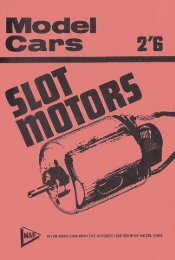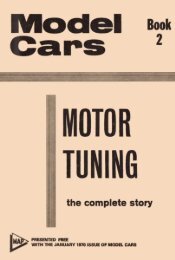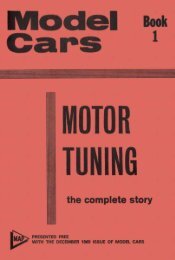Create successful ePaper yourself
Turn your PDF publications into a flip-book with our unique Google optimized e-Paper software.
ests with its heavy side down. Note, however, that a nick on the<br />
edges or wear damage on the shaft can also cause the arm to stop in<br />
certain positions and fool you. To avoid this, try the armature several<br />
times in different positions in different places on the blades. If the<br />
same pole (mark them A, B and C for easy identification) always<br />
'hangs down', your arm is obviously out of balance.<br />
NOTE: an even better method, especially with small amounts of<br />
unbalance, is to lean the wood piece with the razor blades slightly<br />
and have the armature roll down them slowly. If the arm rolls with<br />
the same speed, the static balance is OK. But if it rolls in a 'calypso<br />
rhythm', work is needed. Let us start with method A , removing<br />
weight from the heavy side.<br />
There are different ways of doing this, as the photos will show.<br />
The old Champion balancing, grinding off big slices, is the worst. It<br />
will short circuit many plates and make for higher core losses due to<br />
eddy currents, as explained earlier.<br />
The Dyna method of filing notches will short circuit less plates, but<br />
still leave a rather long scar in the pole face.<br />
The best way of removing weight is by drilling holes, since the<br />
least pole area will be disturbed. All motors of quality (Champion has<br />
switched to this method on its new series) have this kind of<br />
balancing.<br />
However, drilling holes in the hard pole surface without slipping<br />
accidentally into the wires is not easy. Experience speaks. Therefore.<br />
I recommend the beginner to use the notching method instead, by all<br />
means use holes.<br />
Having determined which of the poles is the heaviest, the armature<br />
is clamped in a vice with this pole up. Use inserted pieces of thick<br />
paper or similar, so that the arm will not be marred by the jaws or<br />
the vice. Now grab a thin round file and start working away, holding<br />
it as in the photo (less risk of driving the file into the wires). Please<br />
note that the notch must not necessarily start on the middle of the<br />
pole face (cross-wise), but rather on the exact part of the pole that<br />
is pointing down.<br />
NOTE: always, however, file on the middle of the pole face, lengthwise,<br />
or you might risk further damaging the dynamic unbalance.<br />
Should the notch threaten to grow too big, it will be better to make<br />
two smaller notches beside each other. But don't forget to check the<br />
balance often, so you won't remove too much!<br />
If you use holes, these should be about .05 to .10 in. in diameter<br />
This will depend on the amount of unbalance. If the hole is somewhat<br />
to the side of the pole, don't drill it too deep or you might cut a few<br />
wires.<br />
If you consider it for a second, employing method B and adding<br />
weight to the light side is really much smarter. Notching or drilling in<br />
the poles means less magnetic mass, and though the armature will<br />
run faster when balanced, we have actually lowered torque. Method<br />
B means more (dead) mass, but provided the unbalance, and thus<br />
the mass needed is not too great, we have made an overall gain by<br />
retaining torque.<br />
The method has its limitations; it cannot be used on 'fullhouse'<br />
winds, as there must be space for the weight we are going to add.<br />
Otherwise the method is a simple one.<br />
For best results, we should start while epoxying the armature.<br />
Mix up some epoxy, same as the one used on the armature, and put<br />
it beside the solder iron for quick curing. Then get out some lead<br />
sheet and start filing on it, until you have a nice collection of lead<br />
18






